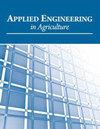Pre- and Post-anthesis Deficit Irrigation of Corn in the West Central Great Plains— Working with Less Water
IF 0.8
4区 农林科学
Q4 AGRICULTURAL ENGINEERING
引用次数: 0
Abstract
HighlightsConcentrating deficit irrigation during the post-anthesis period optimized grain yield and water productivity, while minimizing the seasonal irrigation amount.Corn grain yields were not greatly affected by deficit irrigation strategy, but irrigation amounts varied as much as 62%.Seeding rates ranging from 62,000 to 74,000 corn plants per hectare were acceptable under deficit irrigation.Corn hybrid effects were not consistent across years and location.Abstract. A three-year study (2018 to 2020) was conducted in west central and northwestern Kansas on silt loam soils to determine corn grain yield and yield component response, water use, and crop water productivity as affected by irrigation capacity and timing, corn hybrid, and seeding rate. A range of four irrigation treatments concentrated greater application amounts in either the pre-anthesis or post-anthesis period. The Pre-38 treatment applied 38 mm weekly pre-anthesis as needed (limited by weather-based scheduling) and only applied 38 mm every two weeks during the post-anthesis period. The Pre-25 treatment applied 25 mm weekly as needed pre-anthesis, followed by 25 mm applications every two weeks post anthesis. Post-38 and Post-25 treatments had application amounts similar to Pre-38 and Pre-25, respectively, but had the weekly applications concentrated during the post anthesis period and less frequent (every two weeks) applications pre-anthesis. Two corn hybrids (Pioneer 1197 and Pioneer 0801) were planted at seeding rates of 62 and 74 thousand seeds ha-1. Averaged across location and year, the Pre-25 irrigation treatment had approximately 5% less yield than the other three treatments but received approximately 28% less irrigation. Overall, when averaged across all irrigation, hybrid and seeding rate treatments, the yield components of kernels ear-1 and kernel mass varied approximately 2% and 3%, respectively and were responsible for nearly all of the grain yield variation. The Pre-25 and Post-25 treatment had the greatest water productivity and generally had similar yields to the other deficit irrigation treatments and thus should be considered as effective strategies to reduce irrigation in this region. Seeding corn at 74 thousand seeds ha-1 increased yield only 2% compared with 62 thousand seeds ha-1 indicating that a considerable range of seeding rates produce similar yields when using deficit irrigation strategies in this region. Hybrid effects were not consistent across years and locations. Keywords: Crop water productivity, Evapotranspiration, Irrigation scheduling, Limited irrigation, Maize.中西部大平原玉米花前、花后亏缺灌溉-少水耕作
花期集中亏缺灌溉优化了籽粒产量和水分生产力,同时减少了季节性灌水量。亏缺灌溉对玉米产量影响不大,但灌水量变化幅度可达62%。在亏缺灌溉下,每公顷播种6.2万至7.4万株玉米是可以接受的。玉米杂交效应在不同年份和地区并不一致。在堪萨斯州中西部和西北部进行了一项为期三年(2018年至2020年)的粉砂壤土研究,以确定灌溉能力和时间、玉米杂交和播种率对玉米籽粒产量和产量组成响应、水分利用和作物水分生产力的影响。四种灌溉处理在花前或花后集中了较大的施用量。Pre-38处理在花前根据需要每周施用38毫米(受天气调度限制),在花后期间每两周仅施用38毫米。Pre-25处理在花前每周按需施用25毫米,花后每两周施用25毫米。38后和25后处理的施药量分别与38前和25前处理相似,但每周施药量集中在花后,花前施药量较少(每两周)。两种杂交玉米(先锋1197和先锋0801)播种量分别为62和74 000粒/公顷。在不同地点和年份的平均水平上,25年前灌溉处理的产量比其他三种处理少约5%,但灌溉量却少约28%。总体而言,当在所有灌溉、杂交和播量处理中取平均值时,籽粒穗1和籽粒质量的产量组成分别变化约2%和3%,并且几乎负责所有的籽粒产量变化。25前和25后处理的水分生产力最高,产量与其他亏缺灌溉处理大致相当,应作为该地区减少灌溉的有效策略。播种7.4万粒/公顷的玉米产量仅比播种6.2万粒/公顷的玉米产量增加2%,这表明在该地区,当采用亏缺灌溉策略时,相当大范围的播种率产生相似的产量。杂交效应在不同年份和地点并不一致。关键词:作物水分生产力,蒸散,灌溉调度,限灌,玉米
本文章由计算机程序翻译,如有差异,请以英文原文为准。
求助全文
约1分钟内获得全文
求助全文
来源期刊

Applied Engineering in Agriculture
农林科学-农业工程
CiteScore
1.80
自引率
11.10%
发文量
69
审稿时长
6 months
期刊介绍:
This peer-reviewed journal publishes applications of engineering and technology research that address agricultural, food, and biological systems problems. Submissions must include results of practical experiences, tests, or trials presented in a manner and style that will allow easy adaptation by others; results of reviews or studies of installations or applications with substantially new or significant information not readily available in other refereed publications; or a description of successful methods of techniques of education, outreach, or technology transfer.
 求助内容:
求助内容: 应助结果提醒方式:
应助结果提醒方式:


